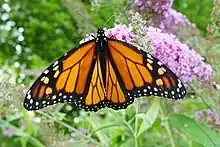List of poisonous animals
The following is a list of poisonous animals, which are animals that passively deliver toxins (called poison) to their victims upon contact such as through inhalation, absorption through the skin, or after being ingested.[1][2] They are often distinguished from venomous animals, which actively inject their toxins (called venom) into their victims through a venom apparatus such as fangs or a stinger.[1][2] The only difference between poisonous animals and venomous animals is how they deliver the toxins.[3][2] This list deals exclusively with poisonous animals.

The hooded pitohui. The neurotoxin homobatrachotoxin on the birds' skin and feathers causes numbness and tingling on contact.
Poisonous animals
This list is a partial list of animals that are poisonous to humans and other animals in that their flesh is toxic if consumed, or in some cases if they are touched:
Mammals
- Slow loris (usually thought of as venomous, but they also lick their fur, making it toxic)[4]
Birds
- Pitohui
- Blue-capped ifrit
- Shrikethrushes
- Spur-winged goose (diet-dependent)[5]
- Common quail (diet-dependent)
Snakes
- Rhabdophis keelback snakes
- Garter snake (diet-dependent, when feeding on Pacific newts)[6]
Frogs and toads
- American toad
- Asiatic toad
- Cane toad
- Colorado River toad
- Common toad
- Corroboree frog
- European green toad
- Fowler's toad
- Mantella
- Poison dart frog
 The bright colors of poison dart frogs warn predators of their toxicity.
The bright colors of poison dart frogs warn predators of their toxicity.
Salamanders

Most birds dislike the taste of monarch butterflies; they contain toxins from poisonous milkweed, ingested as caterpillars.
- Pacific newts or Western newts[7]
Fish
- Tetraodontidae (Blowfish, Pufferfish)
- Greenland shark
- Barracuda (age and diet dependent)
Insects
- Blister beetle
- Diamphidia
- Cinnabar moth
- Certain tiger moths (Erebidae)
- Birdwings
- Milkweed butterflies (include Monarch butterfly)
- Battus (butterfly)
Crustaceans
- Gorilla crabs (Xanthidae)
Cnidarians
Echinoderms
- It is common for sea cucumbers like Pearsonothuria graeffei to protect itself with toxins[10]
- Actinopyga agassizii a toxic sea cucumber
- Some starfish, like Plectaster decanus, are poisonous
Annelids
- The polychaete worm Hediste diversicolor[11]
- Halla parthenopeia[12]
Nemerteans
- Antarctonemertes valida is one of several nemerteans which make use of defensive toxic secretions[13]
Flatworms
- Bipalium kewense, the hammerhead flatworm, is coated in toxic mucus[14]
Sponges
- Negombata magnifica, the toxic finger-sponge, is one of many toxic species of sponges
Placozoans
- Trichoplax use large specialized cells to release antipredatory toxins[15]
See also
References
- Gupta, Ramesh C. (24 March 2017). Reproductive and developmental toxicology. Saint Louis. pp. 963–972. ISBN 978-0-12-804240-3. OCLC 980850276.
{{cite book}}: CS1 maint: location missing publisher (link) - Chippaux, JP; Goyffon, M (2006). "[Venomous and poisonous animals--I. Overview]". Médecine Tropicale (in French). 66 (3): 215–20. ISSN 0025-682X. PMID 16924809.
- "Poison vs. Venom". Australian Academy of Science. 3 November 2017. Retrieved 17 April 2022.
- Nekaris, K. Anne-Isola; Moore, Richard S.; Rode, E. Johanna; Fry, Bryan G. (2013-09-27). "Mad, bad and dangerous to know: the biochemistry, ecology and evolution of slow loris venom". Journal of Venomous Animals and Toxins Including Tropical Diseases. 19 (1): 21. doi:10.1186/1678-9199-19-21. ISSN 1678-9199. PMC 3852360. PMID 24074353.
- Bartram, S.; Boland, W. (2001). "Chemistry and ecology of toxic birds". ChemBioChem. 2 (11): 809–811. doi:10.1002/1439-7633(20011105)2:11<809::aid-cbic809>3.0.co;2-c. PMID 11948866. S2CID 6259254.
- Williams, Becky L.; Brodie Jr., Edmund D.; Brodie III, Edmund D. (2004). "A resistant predator and its toxic prey: persistence of newt toxin leads to poisonous (not venomous) snakes" (PDF). Journal of Chemical Ecology. 30 (10): 1901–1919. doi:10.1023/B:JOEC.0000045585.77875.09. PMID 15609827. S2CID 14274035.
- "Western Newts". Toxic Animals Around The World. December 2005.
- "Kings of Camouflage". NOVA. April 3, 2007. "Well, it turns out the flamboyant cuttlefish is toxic. It's as toxic as blue-ringed octopuses."
- Rowlett, Joe (2018-04-11). "Rhodactis Mushroom Corals Are Surprisingly Deadly". Reefs.com.
- Pearsonothuria graeffei – Invertebrate Zoology
- An investigation into the toxicity of tissue extracts from two distinct marine Polychaeta
- Toxicity of the purple mucus of the polychaete Halla parthenopeia (Oenonidae) revealed by a battery of ecotoxicological bioassays
- Evolution, Expression Patterns, and Distribution of Novel Ribbon Worm Predatory and Defensive Toxins
- Meet, but don't touch, the toxic invasive worm that experts say has been hiding in plain sight
- Neural versus alternative integrative systems: molecular insights into origins of neurotransmitters - Journals
This article is issued from Wikipedia. The text is licensed under Creative Commons - Attribution - Sharealike. Additional terms may apply for the media files.